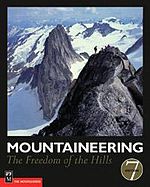- Mountaineering: The Freedom of the Hills
-
 8th edition cover
8th edition cover
Mountaineering: The Freedom of the Hills is often considered the standard textbook for mountaineering and climbing. The book was first published in 1960 by The Mountaineers of Seattle, Washington. The book was written by a team of over 40 experts in the field and is suitable reading for all mountaineers, from beginners to experts.
The book grew out of the annual climbing course run since 1935 by the Mountaineers, for which the reading material was originally a combination of European works and lecturers' mimeo outlines. These were assembled into the Climber's Notebook and published by the Mountaineers as the hardbound Mountaineers Handbook in 1948. By 1955 the rapid postwar evolution of climbing techniques and tools had made the Handbook out of date, and the effort was begun to produce Freedom of the Hills. Nearly 80 major contributors are credited in the first edition and were organized by a committee of 8 editors.
The first four editions were only available in hardcover.
Contents
5th Edition
The 5th edition of the book is split into four parts over 17 chapters:
- Part One: Approaching the Peaks
- Part Two: Climbing Fundamentals
- Part Three: Rock Climbing
- Part Four: Snow and Ice Climbing
There are four appendices and an index. 447 pp.
Chapters
- First Steps
- Clothing and Equipment
- Camping and Food
- Routefinding and Navigation
- Wilderness Travel
- Ropes, Knots, and carabiners
- Belaying
- Rappeling
- Rock Climbing Techniques
- Leading and Placing Protection
- Aid Climbing and Pitoncraft
- Snow Travel and Climbing
- Glacier Travel and Crevasse Rescue
- Ice Climbing
- Winter and Expedition Climbing
- Safety and Leadership
- Alpine Rescue
7th Edition
Chapters
- First Steps
- Clothing and Equipment
- Camping and Food
- Physical Conditioning
- Navigation
- Wilderness Travel
- Leave No Trace
- Basic Safety Systems
- Belaying
- Rappelling
- Alpine Rock Climbing Technique
- Rock Protection
- Leading on Rock
- Aid Climbing
- Snow Travel and Climbing
- Glacier Travel and Crevasse Rescue
- Alpine Ice Climbing
- Waterfall Ice and Mixed Climbing
- Expedition Climbing
- Leadership
- Safety
- First Aid
- Alpine Rescue
- Mountain Geology
- The Cycle of Snow
- Mountain Weather
Editions
Edition Year Editor(s) Size ISBN 1st 1960 Harvey Manning 430 pp. 2nd 1967 Harvey Manning 485 pp. 3rd 1974 Peggy Ferber 478 pp. 4th 1982 Ed Peters 550 pp. 5th 1992 Don Graydon 447 pp. ISBN 0-89886-201-9 or ISBN 0-89886-309-0 6th 1997 Don Graydon and Kurt Hanson 528 pp. 7th 2003 Steven M. Cox and Kris Fulsaas 575 pp. ISBN 0-89886-827-0 8th 2010 Ronald C. Eng 592 pp. ISBN 978-1-59485-137-7 The title as a reference
The title of the book is a reference to the ancient medieval European tradition of "Freedom of the City", that conferred upon the recipient access to a city. The reference implies that with the knowledge in the book, a certain equivalent freedom of the wild mountains can be attained.
External links
Categories:- 1960 books
- Mountaineering books
Wikimedia Foundation. 2010.

